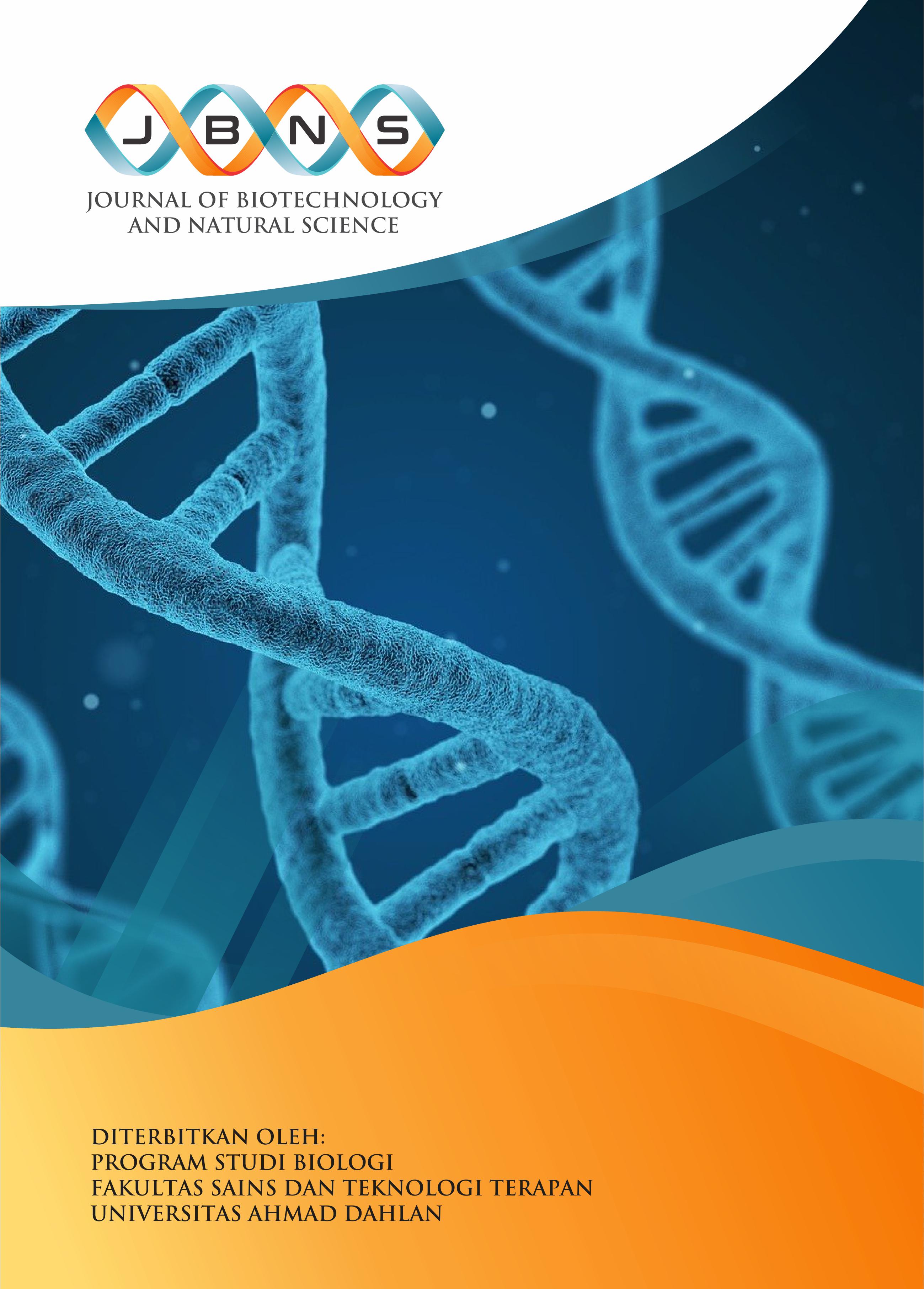Ethanolic Extracts of Shallot Leaves (Allium ascalonicum L.) as Botanical Pesticide for Controlling Fall Armyworms (Spodoptera fugiperda J.E. Smith)
DOI:
https://doi.org/10.12928/jbns.v1i2.5467Keywords:
botanical pesticide, shallot leaves, fall armyworm, macerationAbstract
The application of botanical pesticide is a positive long term approach to control S. frugiperda. Shallot leaves contain acetogenin compound, hence it has the potential to become botanical pesticide. This study is aimed at finding out the effects of ethanolic extract of shallot leaves on S. frugiperda larvae in vitro. Extract is prepared using maceration method with ethanol solvent. The method of treatment is Leaf Dipping. The study applies Completely Randomized Design with concentration of shallot leaf extract as treatment at 0 ppm, 250 ppm, 500 ppm, 750 ppm dan 1000 ppm. Each treatment consists of four repetitions. Examination is conducted for 24 hours. Examination parameter is mortality of larvae and LC50. Data are analyzed with One Way ANOVA (proceeded with LSD) and Probit analysis. The results suggest that shallot leaf extract at the concentration of 1000 ppm appears to be the most effective on the mortality of larvae. The obtained LC50 value is 263,02 ppm. The study indicates that shallot leaf extract can be applied as an alternative synthetic insecticide to control ini S. frugiperda.
References
Arya, M., and Tiwari, R. (2013). Efficacy of plant and animal origin bioproducts against lesser grain borer, Rhyzopertha dominica (fab.) in stored wheat. International Journal of Recent Scientific Research, 4(5), 649-653.
Blessing, L. T., Colom, O. A., Popich, S., Neske, A. and Bardon, A. (2010). Antifeedant and toxic effects of acetogenins from Annona montana on Spodoptera frugiperda. Journal of Pest Science, 83, 307-310. https://doi.org/10.1007/s10340-010-0299-0
Blessing, L. D., Ramos, J., Diaz, S., Ben Altabef, A., Bardón, A., Brovetto, M., Seoane, G. and Neske, A. (2012). Insecticidal properties of annonaceous acetogenins and their analogues interaction with lipid membranes. Nat Prod Commun, 7(9), 1215-8. https://doi.org/10.1177/1934578X1200700929
CABI. (2019). Spodoptera frugiperda (Fall Armyworm). https://www.cabi.org/ISC/fallarmyworm. Accessed in December 9th 2021.
Food and Agriculture Organization, CABI. (2019). Community-Based fall armyworm (Spodoptera frugiperda) monitoring, early warning and management. Training of Trainers Manual, First Edition.
Hidalgo, J. R., Parellada, E. A., Bardón, A., Vera, N. and Neske, A. (2018) Insecticidal activity of annonaceous acetogenins and their derivatives on Spodoptera frugiperda Smith (Lepidoptera: Noctuidae). Journal of Agricultural Chemistry and Environment, 7, 105-116. https://doi.org/10.4236/jacen.2018.73010
Isman, M. B. (2006). Botanical insecticides, deterrents, and repellents in modern agriculture and an increasingly regulated world. Annual Review Entomology, 51, 45-66. https://doi.org/10.1146/annurev.ento.51.110104.151146
Jirnmci, E. (2014). Efficacy of botanical extracts against termites, Macrotermes spp. (lsoptera: Termiticlae) under laboratory conditions. Agric Res, 9(2), 60-73. https://doi.org/10.3923/ijar.2014.60.73
Kementerian Pertanian. (2019). Pengenalan Fall Armyworm (Spodoptera frugiperda J.E. Smith) hama baru pada tanaman jagung di Indonesia. Jakarta: Balai Penelitian Tanaman Serealia.
Martínez, A. M., Aguado-Pedraza, A. J., Viñuela, E., Rodríguez-Enríquez, C. L., Lobit, P., Gómez, B. and Pineda, S. (2017). Effects of ethanolic extracts of Argemone ochroleuca (Papaveraceae) on the food consumption and development of Spodoptera frugiperda (Lepidoptera: Noctuidae). Florida Entomologist, 100(2), 339-345. https://doi.org/10.1653/024.100.0232
Massarolli, A., Pereira M. J. B., and Foerster. L. A. (2016). Annona mucosa Jacq. (Annonaceae): a promising phytoinsecticide for the control of Chrysodeixis includens (Walker) (Lepidoptera: Noctuidae). Journal of Entomology, 13, 132-140. https://doi.org/10.3923/je.2016.132.140
Meriga, B., Mopuri, R., and Murali, K. T. (2012) Insecticidal, antimicrobial and antioxidant activities of bulb extracts of Allium sativum. Asian Pac J Trop Med, 5(5), 391-5. https://doi.org/10.1016/S1995-7645(12)60065-0
Plantus. (2008). Tanaman Obat. http://www.Ipteknet.co.id. Accessed in December 1st 2021.
Silva, M. S., Broglio, S. M. F., Trindade, R. C. P., Ferrreira, E. S., Gomes, I. B. and Micheletti, L. B. (2015). Toxicity and application of neem in fall armyworm. Comunicata Scientiae, 6(3), 359-364. https://doi.org/10.14295/cs.v6i3.808
Souza, C. M., Baldin, E. L. L., Ribeiro, L. P. et al. (2017) Lethal and growth inhibitory activities of Neotropical Annonaceae-derived extracts, commercial formulation, and an isolated acetogenin against Helicoverpa armigera. J Pest Sci, 90, 701-709. https://doi.org/10.1007/s10340-016-0817-9
Tolosa, D., Alvarez, C. O., Bardón, A. and Neske, A. (2012). Insecticidal effects of acetogenins from Rollinia occidentalis seed extract. Nat Prod Commun, 7(12), 1645-6. https://doi.org/10.1177/1934578X1200701226:
Downloads
Published
Issue
Section
License
Copyright (c) 2022 Diah Asta Putri, Pradipta Nur Aini

This work is licensed under a Creative Commons Attribution-ShareAlike 4.0 International License.

